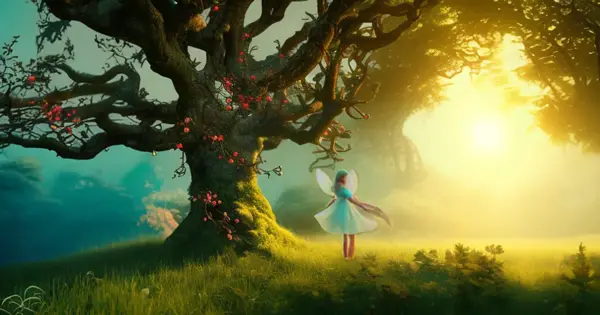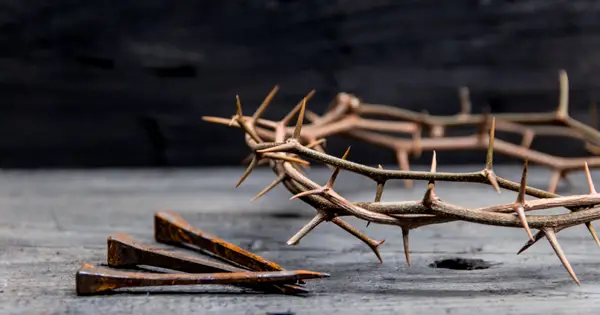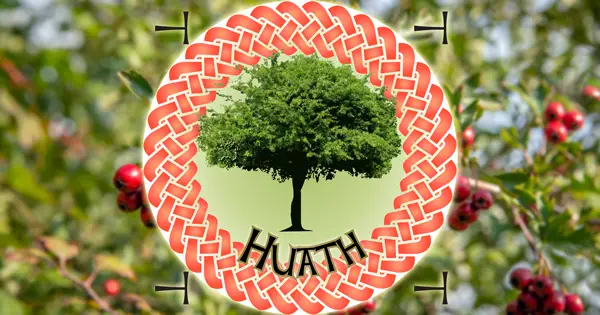The mythology of the Hawthorn tree goes back thousands of years, especially in the Irish Celtic culture, where it is steeped in meaning and symbolism and often referred to as the fairy tree.
The hawthorn is often associated with a realm called the Otherworld, home to mythical creatures and gods. It was believed to serve as a doorway between our world and this mystical realm. Legend has it that fairies, known as the Sidhe, reside within the hawthorn, and disturbing them can bring about serious consequences. No wonder it’s known as the fairy tree!
It is often referred to as the gentle bush, lone bush or thorn, as it is disrespectful to mention the fairies by name.
Bad luck to cut the fairy tree
As it is considered a fairy tree, it is believed to be extremely bad luck to cut one down, remove branches, or even hang things upon it (except at Beltane when this was customary) in case you disturb the little folk.

This belief has survived into modern times. It is not unusual in Ireland to see old, gnarled hawthorn trees standing alone in the middle of fields after every other tree and bush has been removed. Even in the modern scientific world of intensive farming, there are people who don’t want to test their luck by cutting down a hawthorn.
- In 1999 work was interrupted on the main road from Limerick to Galway because a fairy tree stood in its path. The road had to be rerouted and construction was delayed for 10 years.
- In 2009 there were numerous sightings of an ancient ghost thought to reappear in Tyrone after the felling of a fairy tree.
Few people will speak of the fairy tree out of a mixture of fear and respect and even fewer would ever remove or damage a hawthorn standing alone.
Couples fell in love under the hawthorn blossom

Contrary to these beliefs, in Britain, the hawthorn was associated with love and springtime, as the warm weather of May would bring couples together under the sweet blossoms of the hawthorn.
Hawthorn branches hung above a door were believed to protect from evil spirits rather than incurring their wrath.
In ancient Greece, likewise, the hawthorn was associated with love and marriage. Hawthorn crowns were worn by brides as decorative headwear and a hawthorn branch would be used as a wedding torch, perhaps where the phrase ‘carry a torch for’ comes from, meaning to love or have strong feelings for.
Huath, Huathe, H – the hawthorn represents the sixth letter of the ogham alphabet and the sixth month on the Celtic tree calendar, the last weeks of May, when the hawthorn blossom is in flower.
Jesus’ crown of thorns

The tree even has a role in Christianity.
Christian scholars believed that hawthorn branches may have formed the crown of thorns that adorned the head of Jesus Christ at the Crucifixion.
The thorns are not only sharp but very strong and so would be excruciatingly painful and hard to remove or brush away. It would have been a particularly effective though cruel form of punishment.
The hawthorn’s blossoms, which appear around the month of May, are often seen as a symbol of hope, renewal, and purity.
The blossom can be used to adorn holy wells in May, often around the time
This connection to the season of spring reinforces its association with the resurrection of Christ and the promise of eternal life.
Hawthorn in traditional medicine

On a medicinal level hawthorn berries, leaves and flowers were thought in ancient traditions to strengthen the heart and circulation and to balance blood pressure. Rich in vitamins and other nutrients, the plant has been used for such purposes for generations and is even thought to have been a part of the Neolithic diet.
Even into the early part of the last century, children in Ireland were known to eat hawthorn leaves in spring, before the tree blossomed, as a tasty snack to keep them going as they made their way home for dinner.
These are some of the health benefits that the Celts thought the hawthorn provided. It’s by no means certain these claims would pass modern medicinal research so don’t take them as being reliable and always seek medical advice.
- Heart Health: Hawthorn is renowned for its cardiovascular benefits. It improves blood circulation, strengthens the heart muscles, and regulates blood pressure. It can also help alleviate symptoms of angina and reduce the risk of heart disease.
- Digestive Aid: The hawthorn berry has been used as a digestive tonic, promoting healthy digestion and relieving symptoms of indigestion, bloating, and stomach cramps.
- Anxiety and Sleep Disorders: Hawthorn has calming properties that help reduce anxiety and stress and promote restful sleep. It acts as a natural sedative, aiding in the treatment of insomnia and nervous disorders.
- Antioxidant and Anti-inflammatory Effects: The high antioxidant content in hawthorn helps combat oxidative stress, protecting the body against free radicals and reducing inflammation.
- Diuretic and Kidney Support: Hawthorn has diuretic properties, promoting urine production and assisting in the elimination of toxins. It supports kidney function and helps prevent urinary tract infections.
- Skin Conditions: Hawthorn extracts have been used topically to treat skin conditions like eczema, psoriasis, and acne due to their anti-inflammatory and antioxidant effects.
Hawthorn mythology lives on Celtic traditions

The hawthorn tree, with its rich historical and symbolic significance, coupled with its impressive medicinal properties, is an enduring presence in Celtic folklore and traditional medicine.
Whether revered for its magical associations or appreciated for its therapeutic benefits, the Celtic hawthorn tree continues to captivate hearts and minds, bridging the gap between ancient wisdom and contemporary applications.
Tree of Life – meaning and symbolism
trees.html”]
Celtic Cross
Brigid’s Cross

